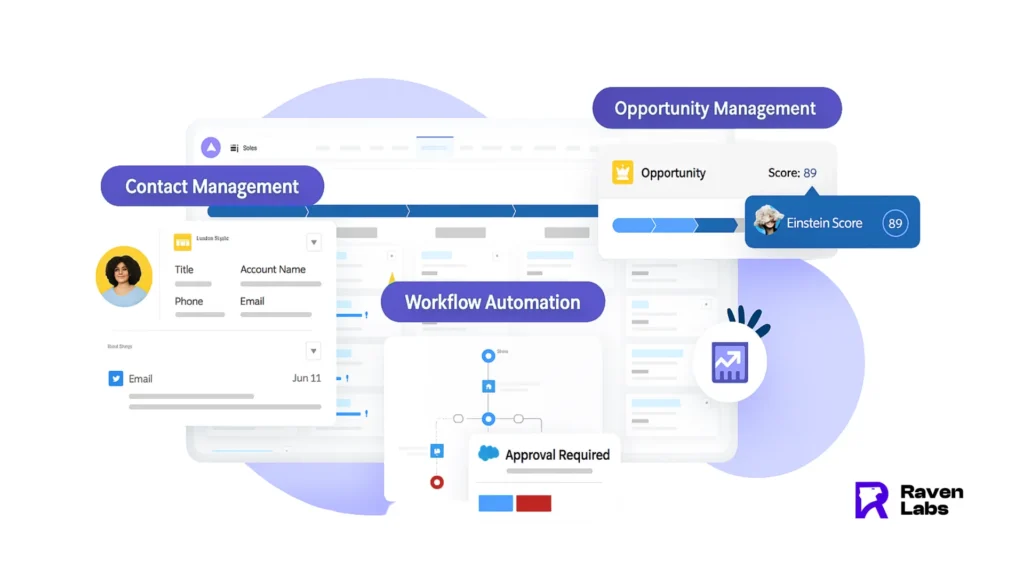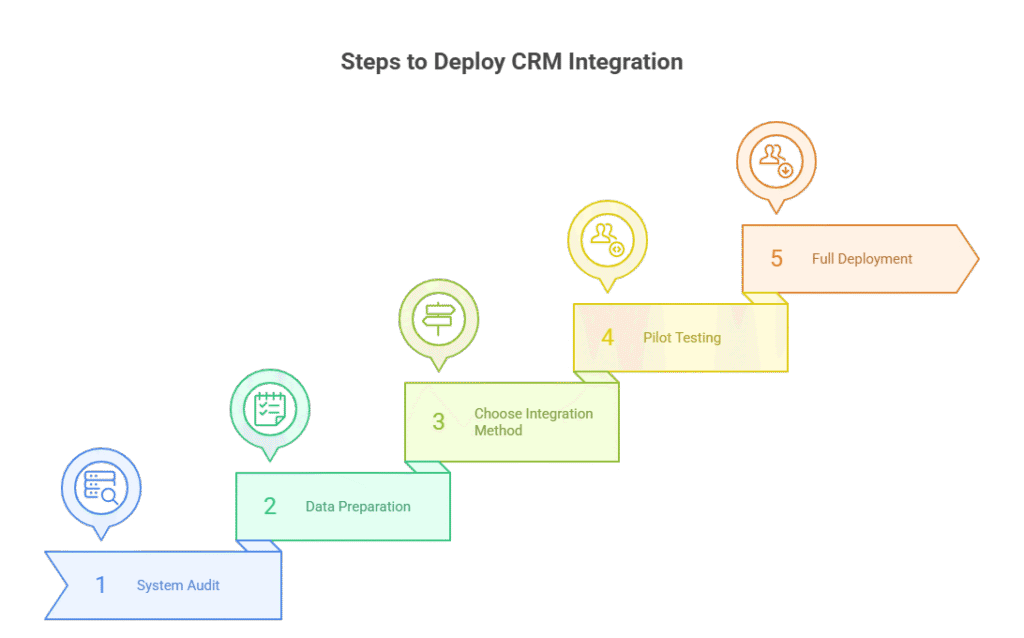
CRM Integration Services: Quick Guide

Introduction
Modern businesses face a striking reality – employees toggle between apps and interfaces more than 1,100 times daily. Companies now use an average of 112 SaaS applications in 2023. This makes integration not just an option but a necessity. The need to integrate CRM and other business systems has become crucial for streamlined operations and enhanced customer experiences.
Building a complete CRM integration strategy might seem daunting at first. The results speak for themselves though – 93% of businesses achieve better customer retention rates after implementing integrated CRM solutions. These integrations help businesses run smoothly. They also streamline communications, build stronger customer relationships and boost sales growth.
Many businesses struggle to navigate CRM integration tools and API-based options. At Raven Labs, our experts simplify the process helping you select, configure, and optimize the right solution so your systems work seamlessly together. Contact us today to streamline your integration journey.
What are CRM Integration Services?
CRM integration services link your customer relationship management platform to other business apps. This creates a unified system where data moves naturally across your organization. These services break down the digital barriers that form when businesses use multiple software solutions for different departments.
The main goal of CRM integration services focuses on automated data sync between systems. When information updates in one app, the changes show up on all connected platforms live.
Integration services work through several mechanisms:
- API-based CRM integration – The most common and flexible approach where systems communicate through Application Programming Interfaces, allowing for customized data exchange protocols.
- Native integrations – Pre-built connectors developed specifically for popular software combinations that offer quick setup with limited customization.
- Middleware integration – Third-party CRM integration tools that act as translators between systems that wouldn’t otherwise communicate effectively.
- Custom development – Tailored solutions created by developers to address specific business needs when standard options aren’t enough.

The technical setup behind these integrations includes data mapping, triggers, and transformation rules. Data mapping links matching fields between systems. Triggers start data transfers, and data transformation rules adjust information as it moves between systems.
A strong CRM integration strategy coordinates entire business processes across platforms. This creates automated CRM workflows spanning multiple systems
CRM and ERP integration creates one of the most effective connections. It joins customer-facing operations with back-office tasks like inventory, order processing, and financial management.
Cloud-based integration makes third-party CRM integration more available. Cloud-to-cloud integrations remove many technical barriers that once made integrations too complex for smaller companies.
Advantages Of Using CRM Integration Services
CRM integration services turn scattered business systems into a unified ecosystem. These integrations bring clear benefits that affect your bottom line by improving data quality, team cooperation, customer satisfaction, and operational performance.
Streamline Data Management Across Platforms
Unified data management is the foundation of good CRM integration. IBM reports that businesses lose an average of $15 million yearly due to poor data quality. Companies can eliminate this expensive problem by syncing data between marketing, sales, and customer service tools in real-time.
The system automates data flow between applications. Teams spend less time on manual data entry that often leads to mistakes. Sales, support, and marketing teams can rely on accurate customer profiles to make strategic decisions and provide better service.
Enable Seamless Communication Between Teams
One of the biggest advantages of CRM integration services is breaking down barriers between departments. Teams cooperate better when they share access to customer data. Information gaps no longer slow them down.
Built-in communication tools like chat, discussions, and activity feeds let teams share updates instantly. Quick questions get answered right away. Teams avoid endless email chains that slow down projects. This improved collaboration leads to a more cohesive customer experience across all touchpoints.
Personalize Customer Interactions Effectively
Companies need personalization to stay competitive today. Salesforce found that 70% of consumers stay loyal to companies that understand their needs. CRM integration makes large-scale personalization possible by providing a comprehensive view of the customer journey.
Marketing teams can use customer data to create targeted campaigns that strike a chord with specific audiences. They segment customers based on demographics, purchases, and behavior patterns. This level of customer segmentation allows for highly personalized marketing campaigns that resonate with each group.
Support teams provide better service with complete customer profiles at their fingertips. They can see the customer’s full history – purchases, issues, and priorities. Each interaction builds on previous ones to create an experience customers value.
Improve Operational Efficiency And Sales Performance
CRM integration services boost operations in clear, measurable ways. Companies report 29% higher sales productivity with integrated CRM systems. Teams can focus on revenue-generating activities instead of repetitive tasks.
Integrated CRM solutions improve key processes like:
- Lead management and qualification
- Order processing and fulfillment tracking
- Customer inquiry routing
- Follow-up scheduling and communication
Companies see better data accuracy when CRM and ERP systems work together. Information flows smoothly between departments. Teams avoid duplicate work and get more done.
Sales teams spend more time selling and less on paperwork. Salesforce research shows sales reps typically use 64% of their time on non-selling tasks. Smart CRM integrations reduce this by automating data entry and follow-ups. This efficiency boost can lead to increased upsell opportunities and improved cross-sell strategies.
Different Types Of CRM Integrations
CRM systems work best when they connect strategically with other business applications. Each CRM integration type serves a unique business function that expands your platform’s capabilities beyond simple contact management.
Marketing Automation And Campaign Management
Marketing CRM integrations link your customer database with powerful campaign tools. This creates uninterrupted data flow between lead generation and nurturing systems. These tools typically connect email marketing platforms, social media management tools, and detailed
Email marketing is just the start. Advanced marketing automation integrations like HubSpot, Marketo, and Salesforce Marketing Cloud provide:
- Lead scoring and qualification
- Automated lead nurturing through email drip campaigns
- Form and landing page creation to collect data
- Campaign performance tracking and analytics
Sales Pipeline And Lead Tracking
Sales-focused CRM integrations boost how teams track chances and manage customer relationships throughout the sales cycle. These tools change how sales representatives connect with prospects by putting all communication data in one place.
Voice systems like RingCentral or Aircall that blend with CRM let users dial directly from customer records and log call information automatically. Sales professionals can focus on selling instead of paperwork, which matters because studies show representatives spend 64% of their time on non-selling tasks.
These integrations deliver key features including:
- Pipeline visualization to track deal progress
- Automated lead distribution and assignment
- Call recording and transcription
- Proposal and contract management with built-in e-signature options
Customer Support And Service Desk Integration
Customer service integrations connect support platforms with your CRM to give agents detailed customer insights. These connections matter because customers care most about quick issue resolution.
Help desk integrations make support easier by showing all customer information, previous communications, and support tickets in one view. Many CRMs include web-to-case or email-to-case features that create and route support tickets to the right agents automatically.
Live chat integrations work two ways they create leads by capturing prospect information during website visits while helping existing customers by accessing their CRM profiles instantly. Smart systems can suggest helpful articles based on customer questions, which might prevent new support tickets.
Ecommerce And Order Management Integration
Ecommerce CRM integrations link online stores, payment systems, and inventory management tools to improve customer buying experiences. Businesses that connect CRM systems with platforms like Shopify, WooCommerce, or Magento can see their customer’s entire experience.
These integrations update customer profiles with purchase information immediately, showing complete buying patterns and priorities. This creates better shopping experiences through:
- Custom product recommendations
- Related pricing and promotions
- Automated back-in-stock alerts
- Targeted post-purchase follow-ups
For instance, a Magento CRM integration can synchronize order data, customer information, and product catalogs, providing a seamless experience for both customers and internal teams.
Internal Collaboration And Workflow Tools
Internal collaboration integrations connect team communication tools with your CRM to boost cross-departmental coordination. Platforms like Slack (acquired by Salesforce) offer strong CRM integration features that change how teams work together.
These integrations let users:
- Add chat histories to relevant CRM records
- Get CRM notifications through messaging tools
- Create or update CRM records directly from chat platforms
- Invite external customers to collaboration channels
A sales representative could create a new opportunity record in Salesforce without leaving Slack. This eliminates application switching and boosts productivity.

How to Select The Best CRM Integration Partner
Your choice of a CRM integration service partner is a vital decision that will affect your implementation success and long-term value. Finding the right match means you’ll have to assess several factors beyond just the price.
Analyze Business Needs And Goals
Look beyond the technical side and be clear about your business goals. Are you trying to improve sales conversion rates, speed up customer service responses, or make workflows more efficient? The clearer these goals are, the better integration specialists can recommend the right solutions.
A detailed requirements document should include:
- Current pain points and inefficiencies
- Critical business processes needing improvement
- Specific data fields requiring synchronization
- Desired automation workflows
- Reporting and analytics needs
This groundwork helps you assess providers better and usually cuts down implementation time and costs by removing any confusion from the process.
Verify Technical Expertise And API Support
Your integration partner’s technical skills directly determine success. Look for partners who have proven experience integrating your specific CRM platform with your existing tech stack. Ask for case studies or client references from similar projects to verify their expertise.
Along with platform experience, check the partner’s knowledge of API-based CRM integration methods. A skilled team should know their way around REST APIs, webhooks, and other relevant integration protocols. They should also explain how they handle data mapping and transformation key parts of successful integration.
Get specific answers about how they manage:
- API rate limits and throttling
- Authentication and credential management
- Error handling and exception processing
- Data validation and cleaning procedures
Check Security Measures And Compliance
Data privacy regulations make your integration partner’s security practices a top priority. Ask for details about their data security protocols, especially how they handle customer information during integration.
Check for compliance certifications that matter in your industry. Based on your sector, find partners who understand GDPR, HIPAA, PCI DSS, or other rules that apply to your data. Take a close look at their approach to permissions and access controls in integrated systems.
A detailed security assessment should cover:
- Data encryption standards (both in transit and at rest)
- Authentication mechanisms and password policies
- Backup and disaster recovery procedures
- Security incident response protocols
Evaluate Scalability And Long-Term Support
Your relationship with the integration partner goes well beyond the original setup. Make sure they can support your changing needs as your business grows. Talk about how their solution handles more data, users, and connected systems.
Learn about their support model. What support tiers do they offer? What response times can you expect? How do they handle urgent issues after hours? Understanding their update and maintenance process shows how they manage system changes.
Step-by-Step Process To Deploy CRM Integration Services
CRM integration needs careful execution to combine data smoothly across your business systems. A well-laid-out approach creates a unified technology ecosystem that supports your strategic goals without disrupting operations.
Conduct System Audit And Identify Gaps
Critical business processes need mapping to find exact points of data transfer between systems. Manual procedures that automation could improve deserve extra attention. Each process requires identification of specific data elements flowing between systems.
A detailed gap analysis will show the differences between your current and future state. The document must point out redundant data entries, communication issues between departments. Process optimization opportunities through automated workflows also need highlighting.
Prepare And Organize Customer Data
Data quality becomes the priority after completing the audit. Your organization needs consistent data standards across systems to keep information uniform. Standard formats for phone numbers, addresses, and company names make this possible.
Bad records need removal, wrong information needs correction, and incomplete profiles need enrichment. Clean data matters – companies lose $15 million each year due to poor data quality.
A complete mapping document should define the information flow between systems. The document must specify field matches, transformation rules, and validation criteria. These elements maintain data integrity during synchronization.
Choose Integration Method And Connectors
Your specific requirements will determine the right integration approach:
- API-based integration: Offers flexibility and customization but requires technical expertise
- iPaaS (Integration Platform as a Service): Provides pre-built connectors with visual workflow builders
- Native connectors: Simplest option but limited to specific applications and features
- Custom development: Most powerful but resource-intensive approach for unique requirements
The choice depends on factors like up-to-the-minute vs. batch processing needs, data volume, and security requirements. Your team’s technical skills also play a crucial role in selecting the method.
Perform Pilot Testing And Full Deployment
A limited-scope test with some data and users should precede full implementation. The pilot phase reveals potential issues in data syncing, workflow automation, or user experience.
Your team must document all errors or unexpected behaviors during testing. The integration partner should help resolve these issues.
The integration rollout works best in phases. Start with non-critical systems before touching core business functions. This careful approach reduces risk and lets your team adapt to new workflows. Good training helps users understand how to use the newly integrated systems well.

Common Pitfalls And How To Overcome Them
The best-planned CRM integration projects face obstacles that can derail implementation efforts. A clear understanding of these common challenges helps you develop strategies to reduce risks and avoid getting pricey setbacks.
Data Duplication And Inconsistency Issues
Data duplication remains a persistent challenge in CRM integration services, even with careful planning. This happens when multiple systems create separate records for the same customer. The solution lies in strong duplicate detection rules that use matching criteria like email addresses and phone numbers.
Your team needs to decide whether your CRM, ERP, or marketing platform owns customer contact information or purchase history.
Regular data audits help spot inconsistencies before they spread across your ecosystem. Training users about proper data entry methods keeps information accurate from the start.
Integration Failures Between Multiple Tools
Systems with multiple applications often break down at connection points. Organizations don’t deal very well with the technical complexity of multi-system integrations.
These steps will help curb this issue:
- Set up complete error logging and monitoring systems
- Create automated alerts for failed synchronizations
- Build fallback processes for critical business functions during outages
Of course, implementing changes in phases rather than all at once reduces risks.
Security Risks In Data Transfer
Data movement between systems creates weak points. Many teams focus on making integrations work while security takes a back seat.
You can reduce these risks with end-to-end encryption for data transfers, strict API authentication protocols, and regular security checks.
Lack Of System Flexibility For Scaling
CRM integrations that seem perfect at first might break as your business grows. Smart planning prevents this outcome.
Test your integrations with data volumes bigger than what you need now. Whatever your current needs, pick solutions with flexible APIs and customizable data mapping features.
Conclusion
CRM integration services have become essential for businesses of all sizes, no longer just a luxury. Data moves naturally between applications and eliminates silos that hurt productivity and customer experience.
Picking the right integration partner is a vital decision in your CRM experience. Your business needs careful analysis, technical expertise verification, security practice evaluation, and future growth planning.
CRM integration does more than just connect software systems. It builds a foundation for digital change that lets your business handle customer needs better while working more efficiently. Well-executed CRM integration gives your organization a competitive edge, making it one of your most valuable technology investments.
Ready to connect your systems and boost efficiency? Partner with Raven Labs to build a CRM integration that drives growth.
📞 Call us at: +61 432 913 392
📧 Email: info@ravenlabs.com.au
🌐 Visit: Raven Labs
Frequently Asked Questions (FAQs):
Why Should Businesses Invest In CRM Integration Services?
CRM integration services connect your CRM with other business systems to create a single, accurate view of customer data. This improves workflow automation, reduces errors, and boosts efficiency, ultimately enhancing customer experiences and decision-making.
How Long Does CRM Integration Typically Take?
The timeline depends on the complexity and scope — simple integrations can be completed in a few weeks, while larger, highly customized projects may take 6–12 months. Careful planning and testing ensure a smooth, disruption-free rollout.
What Industries Benefit The Most From CRM Integrations?
Industries like retail, finance, healthcare, real estate, hospitality, technology, and professional services see the greatest gains. These sectors benefit from improved data access, better customer insights, and streamlined operations.
Can Existing CRM Systems Be Integrated With New Applications?
Yes, most CRMs can be integrated with new applications through APIs or integration platforms. This allows seamless data synchronization and workflow automation without replacing your existing CRM system.











